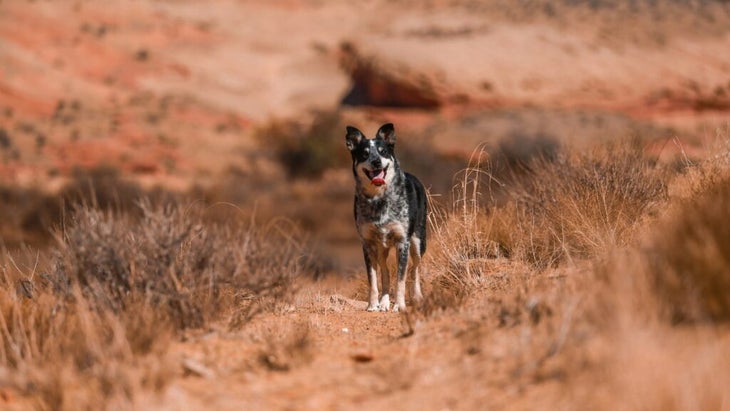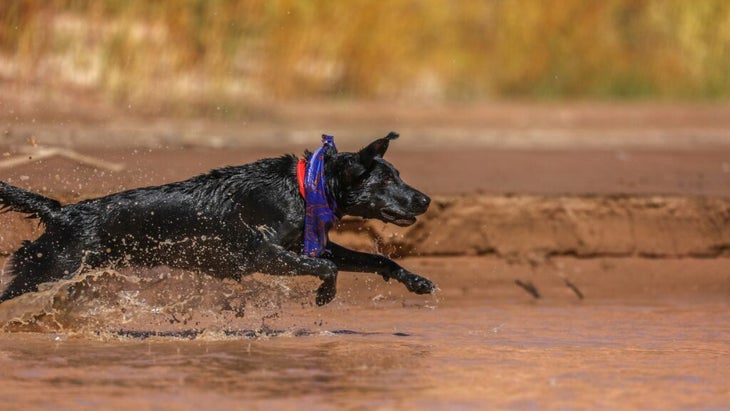New perk: Easily find new routes and hidden gems, upcoming running events, and more near you. Your weekly Local Running Newsletter has everything you need to lace up! Subscribe today.
Running with my dog, Kona, is my favorite way to spend time with her. And, judging by her vigorous tail wagging when I lace up my sneakers, the feeling is mutual. Whenever temperatures rise, though, I pay extra close attention to my devoted running buddy. That’s because, even in mild weather, dogs can overheat quickly, and they’re not very good at telling their humans they need a break. Left unnoticed and untreated, heat exhaustion can lead to heat stroke or even death.
Your dog loves you so much he’s always up for running, and he’ll follow you in any weather. You owe it to him to keep an eye on his condition. But when should you really be worried? How hot is too hot to run with your dog? To find an answer, I gathered expert advice from a dog trainer, veterinarians, and kennel clubs. Here’s what I found.
RELATED: The Ultimate Guide to Running With Your Dog
How hot is too hot?
Because dogs are covered with fur and can’t sweat to cool themselves down, heat illness and injury can sneak up on them fast—even in temperatures that seem relatively mild. That’s especially true for heavyset dogs, larger breeds, and dogs with thicker fur.
Molly Uhlig, a professional dog trainer in Park City, Utah, has six dogs that range from an Aussie-hound mix with black fur to a Husky with a double coat. “Our general rule of thumb is that we really don’t do any extensive exercise [when temperatures are] above the high 60s,” she says.
Your own pup’s limits may differ. Just like humans, every dog has a different capacity for running in warm weather. Uhlig recommends checking a Heat Safety Index chart for dogs, a tool for assessing the heat severity during walks and runs.
In general, veterinarians recommend taking special care when the mercury rises above 75 degrees Fahrenheit—especially if you’re running in direct sunlight or if the humidity index is high. When temperatures hit 80 degrees and humidity sits around 40 percent, caution is in order. And when temps hit 110 degrees at 100 percent humidity, dogs face “extreme danger” of overheating.
Another quick test: If the pavement is hot to the touch, it’s beyond too hot to run with your dog. Their paws can burn and blister even after a few minutes on hot surfaces like cement and asphalt. Dog booties—like these from Ruffwear—can offer some protection. Running in the shade or on a trail can also help, but the safest bet is to run early in the morning when temperatures are cooler or wait to run until temperatures drop in the evening.

RELATED: Why Dogs Are the Best Trail Running Partners
Signs and risks of overheating
Dogs naturally pant to cool down. Rapid inhaling and exhaling increases water evaporation from their nose and lungs, which cools the body from the inside out. But fast and panicked panting is the first sign a dog may be overheating and need some doggy first aid. Uhlig adds that overheated dogs will sometimes try to frantically seek shade. According to the American Kennel Club, other symptoms of overheating include:
- Excessive drooling
- Bugged-out eyes
- Bright red tear ducts, ears, and mucous membranes
- Scooped tongue
- Grayish mouth from lack of oxygen
If a dog can’t cool down and their conditions worsen to include vomiting, diarrhea, and the inability to stand, they need immediate medical attention. Heat stroke in dogs can lead to seizures, brain damage, a coma, or even death. No run is worth any of these consequences.
Experts advise against pouring cold water on your pup when they’re overheating because it can constrict the surface blood vessels and reduce heat loss. But a damp towel on their paws, chest, or belly is fine, according to the American Kennel Club. (I’ve also used the Ruffwear Swamp Cooler Cooling Dog Vest to cool Kona down on hot days.)

Accommodate your pup
After every run, Uhlig makes time for an active cooldown with her dogs. She lets them sniff, rest in the shade, and walk around to return to their normal temperature and heart rate. Uhlig also offers her dogs room-temperature water in a small travel bowl. (Tip: Monitor them closely to prevent overdrinking, which can lead to painful bloating.)
On hot days, Uhlig wakes up earlier to get out the door before the temps spike. Waking up early is hard, Uhlig says, but we owe it to our dogs to get them outside on a schedule that doesn’t put them in danger. “Dogs have a need for physical exercise to be fulfilled and happy,” she says. “They want to go explore and use their bodies. I always tell my clients, ‘You’re a morning person in the summer.’”
If cool morning temperatures aren’t available (an unfortunate reality in places like Phoenix, where the summertime lows are in the 80s), there are other ways to keep your dog moving. Uhlig, for example, has trained dogs to run on a treadmill to ensure they get enough exercise and keep up their training. (She’s planning to releasing a special online training course on the topic.) Indoor agility-course training and summer swims are also good ways to keep your dog active if you don’t have access to an at-home treadmill.
When you are able to run with your dog in the summer, make sure your expectations are properly calibrated. Be prepared to run slower, take sniff and shade breaks, and turn back if it’s too hot for your pup. If they overheat mid-run, stop immediately to rest and wait until they’re feeling well enough to walk home. Remember: Your dog is the priority when you run together, Uhlig says, and the ultimate goal is quality time—not a new PR.
RELATED: Off-Leash Running Can Put Dogs in Danger. Here’s How to Protect Them